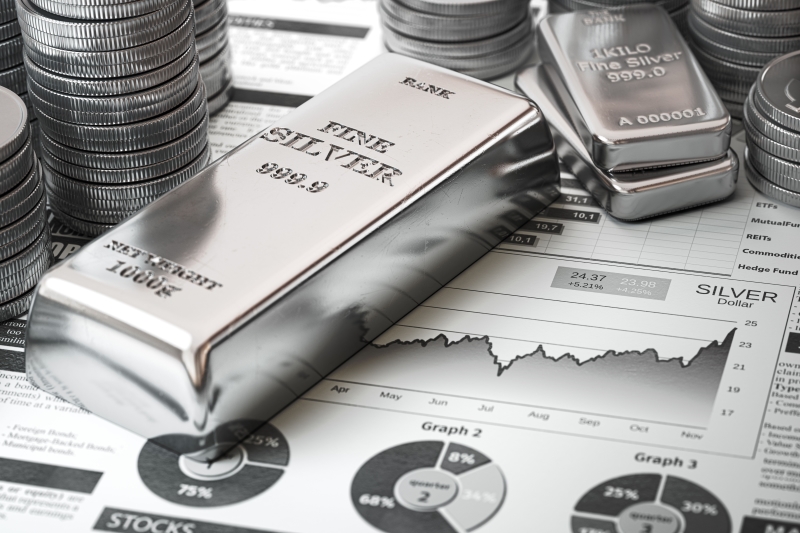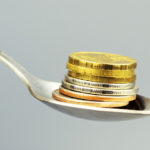Will Silver Catch Up With Gold

(February 21, 2024 - XTB Research)
Precious metals have been in the news again in recent months, linked to new highs for gold above $2,100 per ounce. Looking at the last three years, it is noticeable that there has been no specific trend in the precious metals market, although the price of gold itself has remained quite high. The euphoria associated with palladium has definitely passed, and despite the high hopes associated with platinum, the price of this metal remains clearly below $1000 per ounce. However, investors are wondering why silver is trading only halfway to its historic highs, with gold having permanently registered above $2,000 per ounce. Is silver likely to catch up with gold and also reach historic peaks?
How much should silver cost?
Start investing today or test a free demo
It should be noted that we have about 7 times more silver in the ground than gold. In view of this, it should not surprise us that silver is definitely cheaper than gold bullion. On the other hand, we currently have to pay about 90 ounces of silver for one ounce of gold. Historically, the ratio of silver to gold is just over 50, and in the last 10 years it has been around 80. This means that, keeping the ratio from the average of the last 10 years and with the price of gold at $2,000, silver should cost exactly $25, which is slightly more than it costs now. On the other hand, if the historical price ratio were to be maintained, then silver should cost around $37. This is still lower than silver's historical highs of around $50 per ounce, but about 60% higher than the current price. Do these valuations even make sense when looking at the fundamentals?
There is a significant shortage of silver in the market
For the 10 years to 2020, we saw a fair amount of oversupply in the silver market. In view of this, the silver price then averaged closer to the $15-17 per ounce level. However, from 2021 onwards, the silver market entered into a sizable deficit. This is not only the result of greater investment demand for physical silver, but above all an increase in industrial demand. Around 50% of all global silver demand comes from industry (for 2023, silver demand is around 35,000 tonnes or about 1.1 million ounces), and the strongest growing category is photovoltaics. Given the current energy transition, further dynamic growth can be expected on this side of the category. Investment or jewellery demand is also significant, but at least in the latter case there are no strong growth prospects.
More importantly, the supply of the silver market has remained more or less constant in recent years at just over 1 million ounces (consisting of mining and recovery from so-called scrap). It is also worth noting that the majority of silver mining is related to the mining of other industrial metals such as copper, zinc, nickel and also gold. This is why the supply outlook is also linked to the extraction of other metals. Nevertheless, given the uncertain economic factors (which also affect demand itself), we should not expect a large increase in silver production.
Looking at the supply-demand balance, we have seen a widening deficit since 2021 and the demand-supply advantage is expected to continue this year as well. Despite this, the silver price has been stagnant for more than three years. Why is this happening?
Giant global silver reserves
The latest United States Geological Survey (USGS) report indicates a significant increase in discovered silver reserves in the ground. For 2023, the reserves were expected to increase from 550,000 tonnes to 720,000 tonnes! At current mining levels, there is enough silver for about 27 years. Two countries are primarily responsible for the increase in these reserves: Russia, whose in-ground reserves have almost doubled to 92 thousand tonnes, and Poland, whose reserves have increased to 170 thousand tonnes! Poland has thus jumped into the leading position in terms of holding the largest amount of silver in the world, overtaking Peru. At the same time, Poland is far behind in terms of silver production, mining about 1,300 tonnes per year, which, if current reserves are assessed, would result in the country being able to mine silver for another 130 years! As can be seen, there is still a lot of room to increase silver mining worldwide, although there is a lack of major investment to meet the large potential from PV or also investment demand.
Financial market doubts silver's potential
In 2020, a sudden influx of cash from central banks and governments prompted a search for investment opportunities in almost every market. A massive surge of cash in silver ETFs was then observed. However, since 2020, funds have been shedding silver as investors have been withdrawing their money from the funds. Furthermore, JP Morgan itself has significantly reduced the amount of silver it holds, although there has been speculation for many years that this bank was accumulating massive amounts of silver for a crisis. It also seems that the market is now directing its funds towards other assets such as cryptocurrencies. Following the launch of Bitcoin ETFs in the US, we have seen steady inflows into these funds and outflows for gold and silver ETFs. If this is the case, might silver seem like a good investment?
What's next for silver
The silver price remains above key support near $22 per ounce. This is above the 50 and 200 week moving average. Furthermore, the price of gold remains above $2,000, indicating that silver should be at least around $25, maintaining the average price ratio of the last 10 years. It is also worth remembering that silver, like gold, offers an opportunity to diversify one's portfolio. Typically, precious metals behave slightly differently to the stock market, which is why they are often referred to as safe havens. The upcoming interest rate cuts in the US should also not be forgotten. Lower interest rates will make bonds less attractive and increase the upside prospects for precious metals. Given silver's still relatively low price to gold and far removed from its historical highs, silver may still seem like an attractive investment in the long term. Investment opportunities in silver are numerous, through physical coins and bars, through futures contracts and ETFs. Although silver does not guarantee potentially high returns, as part of an investment portfolio it can be an important part in the form of hedging and diversification.





